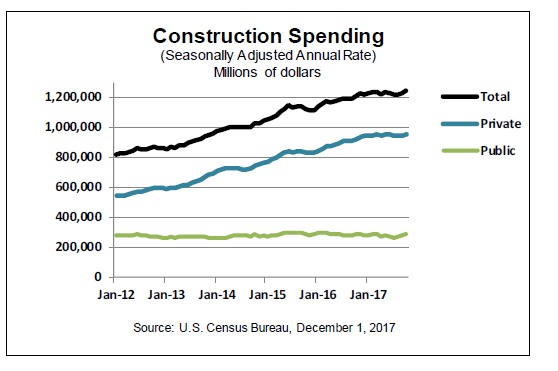The Census Bureau reported a 1.4 Percent Rise in Construction Spending in October from September.
The Econoday consensus only called for a 0.5% rise so let’s start there.
It’s not housing that drove construction spending up a very sharp 1.4 percent in October but non-residential activity which had been lagging in this report. Spending on private non-residential construction jumped 0.9 percent in the month with strength centered in office construction and transportation construction. Despite the improvement, year-on-year spending on the non-residential side is still negative, at minus 1.3 percent. Public building also had a strong month with educational building up 10.9 percent for a standout year-on-year rate of 14.6 percent. Spending on highways & streets was also strong in October, up 1.1 percent though still down on the year, at minus 8.5 percent.Residential spending has been leading this report but October was moderate, up 0.4 percent overall and held back by a 1.6 percent decline for multi-units. But home improvements were strong in the month, up 1.4 percent for an 8.7 percent yearly rate. Total residential spending is up a year-on-year 7.4 percent with spending on new single-family homes up a very significant 8.9 percent.But new homes aside, overall construction spending is up only 2.9 percent which is a very moderate total that evokes this week’s Beige Book where modest-to-moderate still dominated the description of the economy.
Private vs. Public Construction

For the month, public construction rose a whopping 3.9% contributing 0.8 percentage points to the overall rise of 1.4%.
Year-over-year (total construction) numbers show the biggest winners are transportation, education, and lodging.The biggest loser is manufacturing.
Private Construction

Winners and Losers
Private manufacturing is down 14.3% from a year ago, with total manufacturing down 14.1%.
Multi-family housing construction is on the decline, whereas single-family construction is on the rise.
Demographically-speaking, a rise in new, single-family housing is a favorable trend, presuming it means family formation as opposed to meaning that relocating boomers are building new homes and moving.
One of the key sources of job growth growth over the past decade has been the expansion of commercial real estate (big retailers like Walmart, eating establishments, malls, etc).
Commercial real estate construction is up 6.9% from a year ago, but down 1.9% from September. One month does not constitute a trend, but if this is a turn, job growth going forward will weaken.
Hurricane Impacts
Some of the rise in construction spending is due to hurricane fix-ups and forced relocations.
Therefore, I question the sustainability of some recent numbers and also of some short-term trends through the rest of the 2017.
It’s easy to spin the report however one wants, simply by ignoring whichever details do not suit your bias.
I look at the report and see lots of questions.
Mike “Mish” Shedlock



imagine what public construction spending would look like if the Fiscal spending plan actually came to fruition. The question if probably how much of that public construction actually benefits the public?
I think one issue with single family home starts is can builders build starter homes cheap enough for millennials to afford? I was reading a quote from a home builder recently where he can’t build a starter home for <$200k in Cleveland. We are talking Cleveland! Forget about the West Coast or other expensive areas. They probably can’t do it for <$450k due to land costs, regulatory costs, labor costs. There are construction labor shortages everywhere. Young people do not go into the building trades anymore. The average age of the construction worker is much higher then the past. And Mexican immigrants made up 50% of the construction labor force for years and immigration numbers from Mexico are WAY down. This is all inflationary for construction wages and new home prices.
Tremendous report. So many details. And you can spin it any which way. Some of you might ask: What would Trump do? I say, he’d grab it by the plusses.